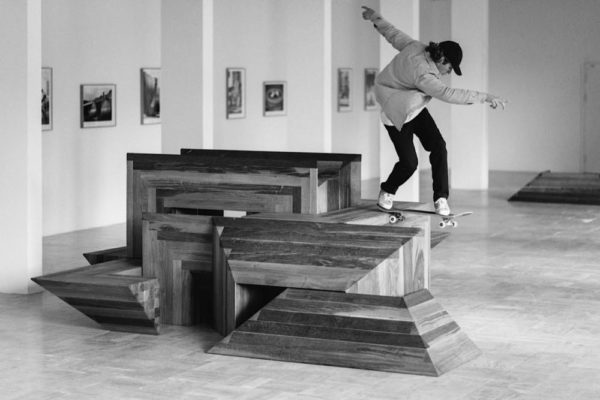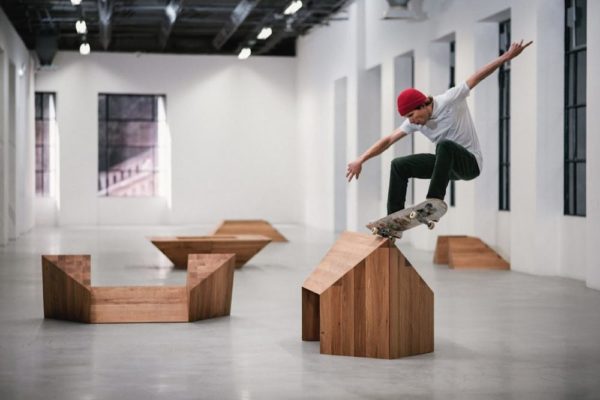
When it comes to the crossover between skateboarding and art museums, there are few precedents. Pro-skater Mark Gonzales coasted sculptures and ramps at high speed at the Museum Abteiberg in Mönchengladbach, Germany, costumed in a fencing suit. Another pro-skater, Chad Muska, has recently designed concrete ramps as art objects, like totems to Richard Serra, erected in a Santa Monica art space. Australian artist Shaun Gladwell invited skaters to contend with replicas of famous Minimalist sculptures as skate obstacles.
“When I studied in art school I really tried to forget my past as a skateboarder,” sculptor Raphaël Zarka tells me, “but I realized when I graduated it was impossible.” The French artist is currently showing some of his modular, skateable sculptures in the exhibition Singing Stones, curated by Katell Jaffres of Paris’s Palais de Tokyo, at the Roundhouse in Chicago—part of the Chicago Architecture Biennial and EXPO CHICAGO. “[Skateboarding] really built up my relationship to spaces, and strategies regarding spaces and materials. So it was important, but I was not so sure how important it was.”
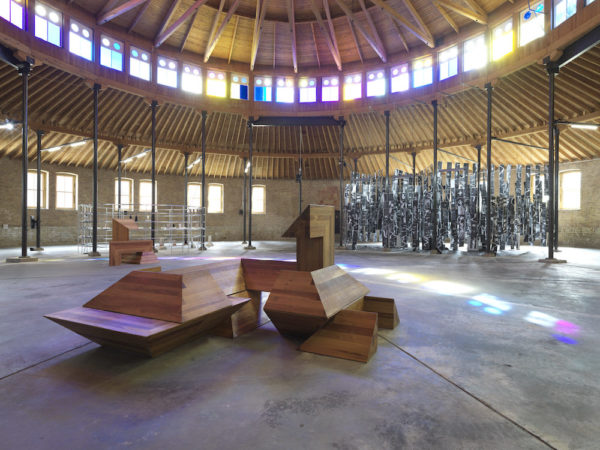
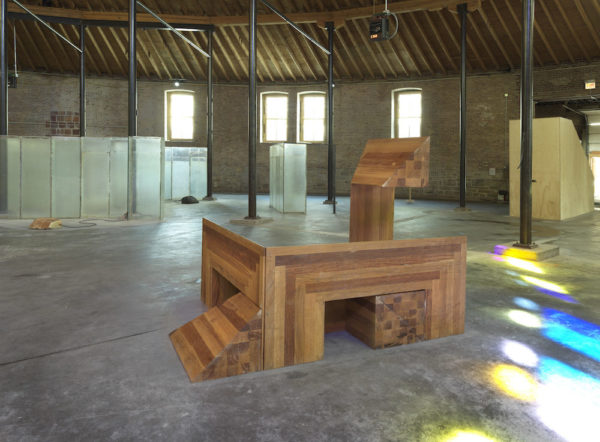
Skateboarding does not lend itself to explication. Try explaining the mechanics of a skate trick to someone who has never stepped foot on a skateboard. It is a practice driven by experience, the knowledge that experience brings and the subculture that arises out of that shared knowledge. Zarka, though, undertook the monumental task of writing down the history of skateboarding—comprehensively reported in his book On a Day With No Waves: A Chronicle of Skateboarding, 1779-2009.
“The wooden modules that appear in Chicago have been exhibited and skated before, bearing very visible traces of their “double life”—waxed, scuffed, and “assaulted” with marks left behind by the skaters.”
I asked Zarka why it was important for him to explain skateboarding to outsiders. “One of the mottos of skaters is ‘shut up and skate!'” Zarka remembered, agreeing, on one level, with the futility of the task. But for something he had spent so much of his teenagehood doing, he says, “First I had to make it clear to myself.” His first treatise on the subject, The Forbidden Conjunction, written in 2003 (also included in On a Day With No Waves), was published by friends in a fanzine-type publication and later picked up by a French curator for inclusion in a journal. The essay became popular among academics and skaters alike. “What I didn’t consider,” Zarka says, “was that a lot of skaters were growing older, just like I was, and they also needed to put words on their teenage experience. A big part of this community is trying to understand on a more intellectual level what they were living spontaneously [in their] youth.”
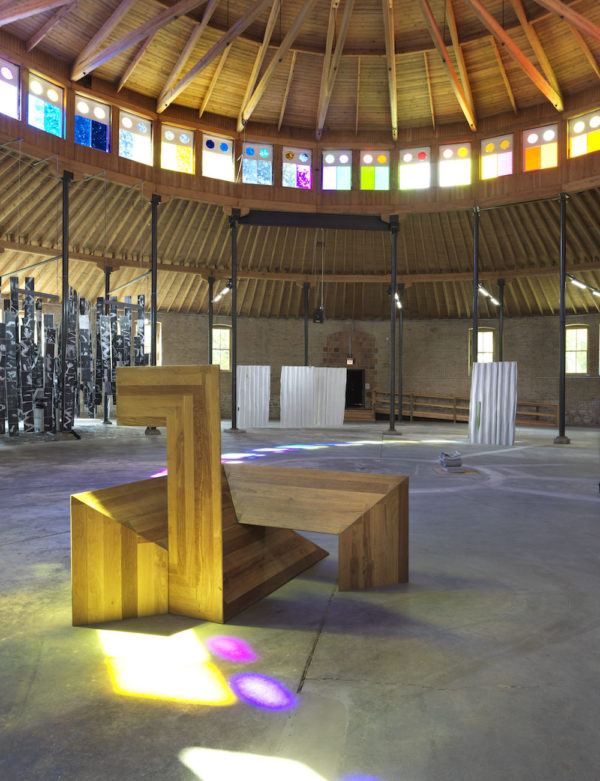
Zarka made his first group of skateable sculptures in 2015. They have been installed four times in the past, and in every case but one they’ve been skated. Unfortunately, due to the constraints of the space and the presence of other artworks in the group exhibition, they aren’t skateable in Chicago. Does that change the sculptures, I ask, if they can only be viewed rather than utilized as skateable objects? “No,” he replies, “these sculptures almost have a double life. If they are successful, they should be able to live a sculptural life of their own in a certain environment and in other situations they are something you can assemble and adapt to the practice of skateboarding. But in that case, then they become something more like props for a performance.” The wooden modules that appear in Chicago have been exhibited and skated before, bearing very visible traces of their “double life”—waxed, scuffed, and “assaulted” with marks left behind by the skaters.
The sculptures—with all their angles and interconnecting planes—do not, however, immediately bring to mind skate obstacles. In fact, Zarka says, “When I started this project, skateboarding was not part of the equation.” Zarka—whose sculptural touchstones include American artists Richard Serra, Michael Heizer, Robert Smithson and Robert Morris and Arte Povera artists Giovanni Anselmo, Mario Merz and Giuseppe Penone—derived the modular structures from the mathematical models designed by Arthur Schoenflies at the end of the nineteenth century which illustrate ways to divide three-dimensional space into infinite configurations. Zarka discovered Schoenflies’s plaster models in a science museum and they provided a way to extend his prior Prismatics series from two-dimensional planes into three-dimensional space. “It’s a sort of questioning about space itself through the history of geometry,” he says.
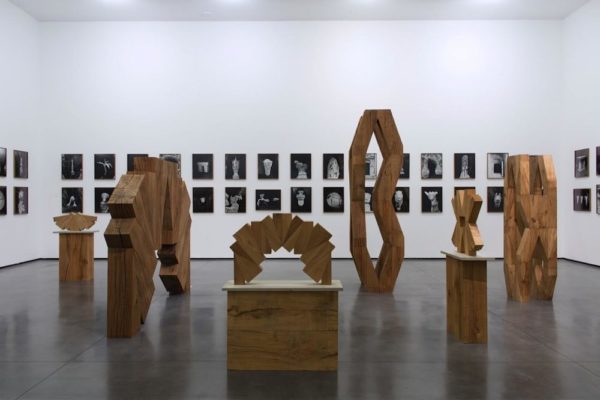
As Zarka was pondering the implications of the Schoenflies modules, a skater friend asked him to participate in a project with the clothing company Carhartt, entreating him to invent a sculptural obstacle for them to skate. While Zarka initially was “not very keen on the idea of skateable sculptures”, they wanted to work with the Schoenflies modules that he was already grappling with, giving him absolute freedom in the design of the sculptures without making concessions for skateability. With the predominance of 45-degree angles in the Schoenflies modules, the sculptures are in fact not easy to skate, and in that way they aptly showcase the ways skateboarders adapt environments and spaces, subverting architectural elements to their own uses.
With this particular project geared toward a skate audience, and with funding provided by Carhartt rather than an art museum or gallery, Zarka says there was no fear of failure, and that kind of liberation led to a rather magical outcome. “These types of moments are absolutely great in an artist’s life,” he says, “[When] you do something and you don’t feel pressure at all. Most of the time when this happens you actually create something meaningful. I didn’t plan that this series would be so meaningful for me and for the evolution of my work.”
“Singing Stones” shows until 29 October at the Roundhouse at DuSable Museum in Chicago.
